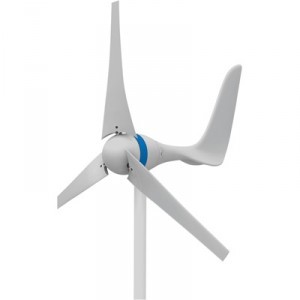
A micro wind turbine is simply a small wind turbine that generates small amounts of electricity (usually under one kilowatt and sometimes as low as 50 watts) from wind energy. Micro wind turbines contrast with the larger wind turbines that are used on wind farms to generate power on a commercial scale. Micro wind turbines are often used on boats or other vehicles to power small appliances such as lights or a refrigeration unit.
Design
Some micro wind turbines are designed for home use. They typically range from seven to 25 feet in diameter (the upper end is rarely used in home energy generation), and have a rated capacity of 300 watts or more.
Most micro wind turbines are traditional horizontal-
Micro wind turbines also rely on dynamic braking to regulate the speed of the rotors for better energy efficiency.
Designs of micro wind turbines vary. The smallest models have direct drive generators and produce direct current electricity. The larger and more expensive models often produce alternating current and use drive train generators, while being actively pointed into the wind, whereas smaller models use passive wind orientation methods such as a vane. Micro wind generators are often designed to be lightweight. The weight of a micro wind turbine designed for home use can be as little as 35 pounds. This makes the turbine sensitive to minor wind movements and more useful in urban areas where winds are subject to being interrupted and intermittent.
Installation
Micro wind turbines for home energy production are often installed on a rooftop, since the smaller, more lightweight design does not require the same load-
Installation issues when putting up wind turbines on a roof include the roof’s load-
Wind turbines can be built from kits (or even from scratch), and most of these are micro wind turbines. The cost of a kit to build a small wind turbine is usually $100 –
installation costs.
World Markets
The U.S. dominates the world market for small wind turbines from the consumer end. U.S. manufacturers also make up almost half the world’s wind energy equipment production for micro wind turbines. Micro wind turbines added over 20 megawatts of total generating capacity (estimated) as of 2012. The cost of a home wind energy system fully installed and generated at least 2 kilowatts of power generally runs $12,000 or more. However, 19 states have tax credits or rebate programs to reduce the cost of wind power.
Other large markets for micro wind turbines include the UK and Japan. Japan has enacted a program of incentives for wind energy production in the wake of the Fukushima nuclear disaster. Although China has implemented an aggressive commercial wind energy generation effort, the market for micro wind turbines in China is not as significant as the potential given the country’s size.
